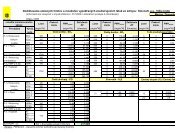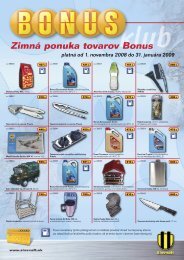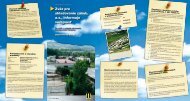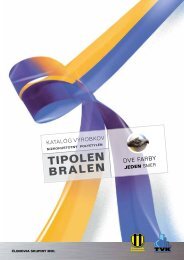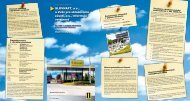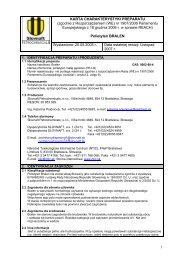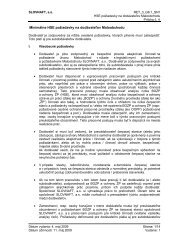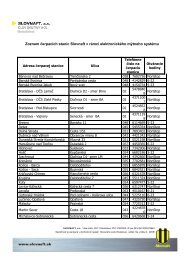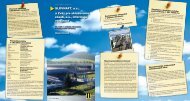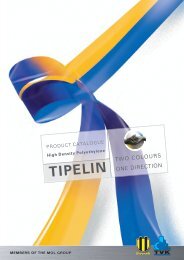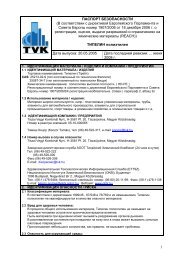pdf, 246 kB - Slovnaft
pdf, 246 kB - Slovnaft
pdf, 246 kB - Slovnaft
- No tags were found...
Create successful ePaper yourself
Turn your PDF publications into a flip-book with our unique Google optimized e-Paper software.
AlkylateSafety Data Sheetaccording to Regulation (EC) No. 1907/2006 (REACH)Date of issue: 02.04.2012 Version: 2.0Revision date: 31.01.20131. Identification of the substance/mixture and of the company/undertaking1.1. Product identifierChemical typeNameTrade name: Substance: Alkylate: AlkylateEC index no : 649-274-00-9EC no : 265-066-7CAS No. : 64741-64-6REACH registration No. : 01-2119485026-38-0011IUPACChemical nameSynonyms: Naphtha (petroleum), full range alkylate: Naphtha (petroleum), full-range alkylate: Alkylate1.2. Relevant identified uses of the substance or mixture and uses advised against1.2.1. Relevant identified usesIndustrial/Professional use spec.Function or use category1.2.2. Uses advised againstNo relevant data available1.3. Details of the supplier of the safety data sheetSLOVNAFT, a.s.Vlčie hrdlo 1824 12 Bratislava - SlovakiaT +421-(0)2/4055-1111 - F +421-(0)2/5859-9759slovnaftreach@slovnaft.sk - www.slovnaft.sk1.4. Emergency telephone number: Use as a fuelUse in Cleaning AgentsUse as an intermediateUses in CoatingsDistribution of substanceFormulation & (re)packing of substances and mixturesManufacture of substanceRubber production and processing: Cleaning/washing agents and additives, Fuels, Impregnation agents, IntermediatesEmergency number : Podnikový dispečing 1: ++0421(0)2/4055 3344Podnikový dispečing 2: ++0421(0)2/4055 2244fax: ++0421(0)2/4055 8047E-mail: podnikovydispecing1@slovnaft.sk, podnikovydispecing2@slovnaft.skCountry Official advisory body Address Emergency numberSLOVAKIAToxikologické informačné centrum FN sLimbová 5+421 2 54 77 4 166833 05 BratislavapoliklinikouUniversity Hospital Bratislava2. Hazards identification2.1. Classification of the substance or mixture2.1.1. Classification according to Regulation (EC) No 1272/2008 [CLP/GHS]Flam. Liq. 2H225Skin Irrit. 2STOT SE 3Asp. Tox. 1Aquatic Chronic 2H315H336H304H411Full text of H-phrases: see section 162.1.2. Classification according to Directive 67/548/EEC or 1999/45/ECF+; R12Xn; R65Xi; R3831.01.2013 EN (English) 1/11
AlkylateSafety Data Sheetaccording to Regulation (EC) No. 1907/2006 (REACH)N; R51/53R67Full text of R-phrases: see section 162.1.3. Adverse physicochemical, human health and environmental effectsNo relevant data available2.2. Label elements2.2.1. Labelling according to Regulation (EC) No 1272/2008 [CLP/GHS]Hazard pictograms (CLP) :Signal word (CLP)Hazard statements (CLP)Precautionary statements (CLP): DangerGHS02 GHS07 GHS08 GHS09: H225 - Highly flammable liquid and vapourH304 - May be fatal if swallowed and enters airwaysH315 - Causes skin irritationH336 - May cause drowsiness or dizzinessH411 - Toxic to aquatic life with long lasting effects: P210 - Keep away from heat, hot surfaces, open flames, sparks. - No smokingP280 - Wear eye protection, face protection, protective clothing, protective glovesP403+P233 - Store in a well-ventilated place. Keep container tightly closedP201 - Obtain special instructions before useP273 - Avoid release to the environmentP331 - Do NOT induce vomiting2.2.2. Labelling according to Directive 67/548/EEC or 1999/45/ECR-phrasesS-phrases2.3. Other hazardsNo relevant data available3. Composition/information on ingredients3.1. SubstancesName Product identifier % (w/w)ConcentrationCAS No.: R12 - Extremely flammable.R38 - Irritating to skin.R65 - Harmful: may cause lung damage if swallowed.R67 - Vapours may cause drowsiness and dizziness.R51/53 - Toxic to aquatic organisms, may cause long-term adverse effects in the aquaticenvironment.: (S2) - (Keep out of reach of children)S23 - Do not breathe gas/fumes/vapour/spray (appropriate wording to be specified by themanufacturer).S24 - Avoid contact with skin.S29 - Do not empty into drains.S43 - In case of fire, use ... (indicate in the space the precise type of fire-fighting equipment. Ifwater increases risk, add -- 'Never use water').S45 - In case of accident or if you feel unwell, seek medical advice immediately (show the labelwhere possible)S51 - Use only in well ventilated areaS53 - Avoid exposure - obtain special instructions before use.S61 - Avoid release to the environment. Refer to special instructions/Safery data sheets.S62 - If swallowed, do not induce vomiting: seek medical advice immediately and show thiscontainer or label.EC no(range)2,2,4-trimethylpentane 540-84-1 208-759-1
AlkylateSafety Data Sheetaccording to Regulation (EC) No. 1907/2006 (REACH)Name Product identifier % (w/w)ConcentrationCAS No.EC no(range)Classification according toDirective 67/548/EECClassification according toRegulation (EC) No 1272/2008[CLP/GHS]propane 74-98-6 200-827-9
AlkylateSafety Data Sheetaccording to Regulation (EC) No. 1907/2006 (REACH)First-aid measures after ingestion: in case of ingestion, always assume that aspiration has occurred.The casualty should be sent immediately to hospitalDo not wait for symptoms to develop.Do not induce vomiting as there is high risk of aspiration.Do not give anything by mouth to an unconscious person.4.2. Most important symptoms and effects, both acute and delayedSymptoms/injuries after inhalationSymptoms/injuries after skin contactSymptoms/injuries after eye contactSymptoms/injuries after ingestion: Inhalation of vapours may cause headache, nausea, vomiting and an altered state ofconsciousness.: Symptoms: reddening, irritation.: Slight eye irritation.: few or no symptoms expected.If any, nausea and diarrhoea might occur.4.3. Indication of any immediate medical attention and special treatment neededNo relevant data available5. Firefighting measures5.1. Extinguishing mediaSuitable extinguishing mediaUnsuitable extinguishing media5.2. Special hazards arising from the substance or mixtureReactivityIngestion (swallowing) of this material may result in an altered state of consciousness and loss ofcoordination.: Foam (trained personnel only). Water fog (trained personnel only). Dry chemical powder. Carbondioxide. Other inert gases (subject to regulations). Sand or earth.: Do not use direct water jets on the burning product;. they could cause splattering and spread thefire. Simultaneous use of foam and water on the same surface is to be avoided as water destroysthe foam.: This substance will float and can be reignited on surface water.5.3. Advice for firefightersProtection during firefightingOther information: In case of a large fire or in confined or poorly ventilated spaces, wear full fire resistant protectiveclothing and self-contained breathing apparatus (SCBA) with a full face-piece operated inpositive pressure mode.: Incomplete combustion is likely to give rise to a complex mixture of airborne solid and liquidparticulates, gases, including carbon monoxide. unidentified organic and inorganic compounds. Ifsulphur compounds are present in appreciable amounts, combustion products may include alsoH2S and SOx (sulfur oxides) or sulfuric acid.6. Accidental release measures6.1. Personal precautions, protective equipment and emergency procedures6.1.1. For non-emergency personnelProtective equipment: Small spillages: normal antistatic working clothes are usually adequate.Large spillages: full body suit of chemically resistant and antistatic material.Work gloves providing adequate chemical resistance, specifically to aromatic hydrocarbons.gloves made of PVA are not water-resistant, and are not suitable for emergency useWork helmet.Antistatic non-skid safety shoes or bootsGoggles and /or face shield, if splashes or contact with eyes is possible or anticipated.Respiratory protection:a half or full-face respirator with filter(s) for organic vapours/H2S, or a Self-contained BreathingApparatus (SCBA) can be used according to the extent of spill and predictable amount ofexposure. If the situation cannot be completely assessed, or if an oxygen deficiency is possible,only SCBA’s should be used.31.01.2013 EN (English) 4/11
AlkylateSafety Data Sheetaccording to Regulation (EC) No. 1907/2006 (REACH)Emergency procedures: Stop or contain leak at the source, if safe to do soAvoid direct contact with released materialStay upwindIn case of large spillages, alert occupants in downwind areas.Keep non-involved personnel away from the area of spillage. Alert emergency personnelExcept in case of small spillages,The feasibility of any actions should always be assessed and advised, if possible, by a trained,competent person in charge of managing the emergency.Eliminate all ignition sources if safe to do so (e.g. electricity, sparks, fires, flaresIn those cases when the presence of dangerous amounts of SO2 or H2S around the spilledproduct is suspected or proved,additional or special actions may be warranted including access restrictions, use of specialprotection equipment, procedures and personnel trainingIf required, notify relevant authorities according to all applicable regulationsIf necessary dike the product with dry earth, sand or similar non-combustible materials.Large spillages may be cautiously covered with foam, if available, to limit vapour cloud formation.Do not use direct jetsWhen inside buildings or confined spaces, ensure adequate ventilation.6.1.2. For emergency respondersNo relevant data available6.2. Environmental precautionsPrevent product from entering sewers, rivers or other bodies of water, or underground spaces (tunnels, cellars, etc.)Absorb spilled product with suitable non-combustible materials.Collect free product with suitable mechanical means.Transfer collected product and other contaminated materials to suitable containers for recovery or safe disposal.In case of soil contamination, remove contaminated soil and treat in accordance with local regulations.In case of small spillages in closed waters, contain product with floating barriers or other equipmentCollect spilled product by absorbing with specific floating absorbentsIf possible, large spillages in open waters should be contained with floating barriers or other mechanical means.Isolate the area and prevent fire/explosion hazard for ships and other structures, taking into account wind direction and speed, until the product iscompletely dispersed.Contain spillage – ventilate area and allow to evaporate.The use of dispersants should be advised by an expert, and, if required, approved by local authorities.6.3. Methods and material for containment and cleaning upFor containment6.4. Reference to other sectionsNo relevant data available: recommended measures are based on the most likely spillage scenarios for this material;however, local conditions (wind, air temperature, wave/current direction and speed) maysignificantly influence the choice of appropriate actionsFor this reason, local experts should be consulted when necessary.Local regulations may also prescribe or limit actions to be takenConcentration of H2S in tank headspaces may reach hazardous values, especially in case ofprolonged storage.This situation is especially relevant for those operations which involve direct exposure to thevapours in the tank.Spillages of limited amounts of product, especially in the open air when vapours will be usuallyquickly dispersed, are dynamic situations, which will presumably limit the exposure to dangerousconcentrations.As H2S has a density greater than ambient air, a possible exception may regard the build-up ofdangerous concentrations in specific spots, like trenches, depressions or confined spacesIn all these circumstances, however, the correct actions should be assessed on a case-by-casebasis.31.01.2013 EN (English) 5/11
AlkylateSafety Data Sheetaccording to Regulation (EC) No. 1907/2006 (REACH)7. Handling and storage7.1. Precautions for safe handlingPrecautions for safe handling: Obtain special instructions before use. Risk of explosive mixtures of vapour and air. Ensure thatall relevant regulations regarding explosive atmospheres, and handling and storage facilities offlammable products, are followed. A specific assessment of inhalation risks from the presence ofH2S in tank headspaces, confined spaces, product residue, tank waste and waste water, andunintentional releases must be made to help determine controls appropriate to localcircumstances. Keep away from heat/sparks/open flames/hot surfaces. Do not eat, drink orsmoke when using this product. Avoid contact with the hot product. Avoid release to theenvironment. Take precautionary measures against static electricity. Ground/bond containers,tanks and transfer/receiving equipment. Use explosion-proof electrical/ventilating/lightingequipment. Use only non-sparking tools. The vapour is heavier than air. Beware of accumulationin pits and confined spaces. Use only bottom loading of tankers, in compliance with Europeanlegislation. Do not use compressed air for filling, discharging, or handling operations. Avoidcontact with skin and eyes. Do not ingest. Do not breathe vapours. Use adequate personalprotective equipment as required. For more information regarding protective equipment andoperational conditions see Exposure scenarios. Ensure that proper housekeeping measures arein place. Contaminated materials should not be allowed to accumulate in the workplaces andshould never be kept inside the pockets. Keep away from food and beverages. Wash the handsthoroughly after handling. Change contaminated clothes at the end of working shift.7.2. Conditions for safe storage, including any incompatibilitiesTechnical measuresStorage conditionsStorage areaSpecial rules on packagingPackaging materials7.3. Specific end use(s): Before entering storage tanks and commencing any operation in a confined area, check theatmosphere for oxygen content and flammability. If sulphur compounds are suspected to bepresent in the product, check the atmosphere for H2S content. Light hydrocarbon vapours canbuild up in the headspace of containers. These can cause flammability / explosion hazards.Open slowly in order to control possible pressure release. Empty containers may containflammable product residues. Do not weld, solder, drill, cut or incinerate empty containers, unlessthey have been properly cleaned.: Cleaning, inspection and maintenance of internal structure of storage tanks must be done onlyby properly equipped and qualified personnel as defined by national, local or companyregulations.: Use and store only outdoors or in a well-ventilated area. Storage area layout, tank design,equipment and operating procedures must comply with the relevant European, national or locallegislation. Storage installations should be designed with adequate bunds in case of leaks orspills. Store separately from oxidising agents.: If the product is supplied in containers: Keep only in the original container or in a suitablecontainer for this kind of product. Keep containers tightly closed and properly labelled. Protectfrom the sunlight.: Recommended materials: For containers, or container linings use materials specifically approvedfor use with this product. some synthetic materials may be unsuitable for containers or containerlinings depending on the material specification and intended use. Compatibility should bechecked with the manufacturer.This substance is handled under Strictly Controlled Conditions in accordance with REACH regulation Article 17(3) for on-site isolated intermediates.in case the substance is transported to other sites for further processing, the substance should be handled at these sites under the StrictlyControlled Conditions as specified in REACH regulation Article 18(4). Site documentation to support safe handling arrangements including theselection of engineering, administrative and personal protective equipment controls in accordance with risk-based management systems isavailable at each manufacturing site. Written confirmation of application of Strictly Controlled Conditions has been received from every affectedDistributor and Downstream Processor/User of the Registrant’s intermediate.8. Exposure controls/personal protection8.1. Control parametersAlkylate (64741-64-6)European Union IOELV TWA (mg/m³) 2400 mg/m³ Isobutane and n-butane with butadiene> = 0,1% butadieneEuropean Union IOELV TWA (ppm) 1000 ppm Isobutane and n-butane with butadiene >= 0.1% butadieneSlovakia NPEL (krátkodobý) (mg/m3) 2400 mg/m³ Isobutane and n-butane with butadiene >= 0.1% butadieneSlovakia NPEL (priemerný) (ppm) 1000 ppm Isobutane and n-butane with butadiene >= 0.1% butadieneDNELPNEC: 1300 mg/m³/15 min Workers:acute exposure, Systematic,Inhalation1100 mg/m³/15 min workers: acute exposure, Lokal ,Inhalation840 mg/m³/8h workers:long term exposure, Lokal, Inhalation,1200 mg/m³/15 min general population: acute exposure, Systematic,Inhalation640 mg/m³/15 min general population: acute exposure, Lokal, Inhalation180 mg/m³/24h general population: long term exposure, Lokal, InhalationSubstance is a hydrocarbon UVCB that poses a chronic marine hazard. The hydrocarbon blockmethod is used for environmental risk assessment.31.01.2013 EN (English) 6/11
AlkylateSafety Data Sheetaccording to Regulation (EC) No. 1907/2006 (REACH)8.2. Exposure controlsPersonal protective equipment: Gloves. Protective clothing. Protective goggles.Hand protectionEye protectionSkin and body protectionRespiratory protectionThermal hazard protectionEnvironmental exposure controlsConsumer exposure controls: Gloves must be periodically inspected and changed in case of wear, perforations orcontaminations. Wear chemically resistant gloves (tested to EN374) in combination with specificactivity training.: Protective goggles.: Wear suitable coveralls to prevent exposure to the skin. Coveralls should be changed at the endof the work shift and cleaned as necessary to avoid transfer of product to clothes or underwear.: to avoid respiratory tract irritation inhalation exposure should be kept to a minimum,. If exposurelevels cannot be determined or estimated with adequate confidence, or an oxygen deficiency ispossible, only SCBA’s should be used. If necessary, approved respiratory protection equipmentshall be used when handling hot product in confined spaces: enclosed face mask withcartridge/filter type ―A‖ or self-contained breathing apparatus (SCBA). Change filter cartridge onrespirator daily.: None in normal conditions.: Store finished products in closed containers (e.g., bulk tanks, drums, cans);. All waste product isassumed to be collected and returned for re-processing or use as a fuel. Carefully handle thesubstance to minimise releases.: Substance registered as Isolated intermediate under SCC). This substance is handled underStrictly Controlled Conditions in accordance with REACH regulation Article 17(3) for on-siteisolated intermediates. In case the substance is transported to other sites for further processing,the substance should be handled at these sites under the Strictly Controlled Conditions asspecified in REACH regulation Article 18(4). Site documentation to support safe handlingarrangements including the selection of engineering, administrative and personal protectiveequipment controls in accordance with risk-based management systems is available at eachmanufacturing site. Written confirmation of application of Strictly Controlled Conditions has beenreceived from every affected Distributor and Downstream Processor/User of the Registrant’sintermediate.9. Physical and chemical properties9.1. Information on basic physical and chemical propertiesAppearance: Liquid.Physical state: LiquidColour: Colourless.Odour: aromatic odour.Boiling point : 45 °CFlash point : < -9 °CExplosive limits (vol %) : 1,2 - 6,4 vol %Vapour pressure: ≤ 40 kPaDensity: 700 - 710 kg/m³Viscosity: ≥ 0,53 m²/s9.2. Other informationThe above data are informative, accurate physical-chemical data of the product are specified on the product certificate.. Stability and reactivity10.1. ReactivityThis substance will float and can be reignited on surface water.10.2. Chemical stabilityStable under normal conditions.10.3. Possibility of hazardous reactionsContact with strong oxidizers (peroxides, chromates, etc.) may cause a fire hazard.10.4. Conditions to avoidThey may be ignited by heat, sparks, static electricity or flames.10.5. Incompatible materialsA mixture with nitrates or other strong oxidisers (e.g. chlorates, perchlorates, liquid oxygen) may create an explosive mass.31.01.2013 EN (English) 7/11
AlkylateSafety Data Sheetaccording to Regulation (EC) No. 1907/2006 (REACH)10.6. Hazardous decomposition productsNo decomposition if stored normally.11. Toxicological information11.1. Information on toxicological effectsSkin corrosion/irritationSpecific target organ toxicity (single exposure)Aspiration hazardAlkylate (64741-64-6)LD50 oral rat> 5000 mg/kgLD50 dermal rat> 2000 mg/kgLC50 inhalation rat (mg/l) 5,61 g/m³: Causes skin irritation.: May cause drowsiness or dizziness.: May be fatal if swallowed and enters airways.12. Ecological information12.1. ToxicityAlkylate (64741-64-6)LC50 fish 1LC50 other aquatic organisms 1EC50 Daphnia 1EC50 Daphnia 212.2. Persistence and degradabilityNo relevant data available12.3. Bioaccumulative potentialNo relevant data available12.4. Mobility in soilNo relevant data available8,2 - 10 mg/l0,5 - 3,1 mg/l4,5 mg/l2,6 ml/l12.5. Results of PBT and vPvB assessmentAlkylate (64741-64-6)Results of PBTassessment12.6. Other adverse effectsNo relevant data available13. Disposal considerations13.1. Waste treatment methodsRegional legislation (waste)Waste treatment methodsSewage disposal recommendationsWaste disposal recommendationsAdditional informationEcology - waste materialsAnthracene is not present in this substance at greater than 0,1% no other representative hydrocarbons structures werefound to meet the PBT/vPvB criteria: DIRECTIVE 2008/98/EC OF THE EUROPEAN PARLIAMENT AND OF THE COUNCILof 19 November 2008on waste and repealing certain Directives.: Contain and dispose of waste according to local regulations. External recovery and recycling ofwaste should comply with applicable local and/or national regulations. External treatment anddisposal of waste should comply with applicable local and/or national regulations. Wherepossible (e.g. in the absence of relevant contamination), recycling of used substance is feasibleand recommended.: Do not empty into drains, dispose of this material and its container at hazardous or special wastecollection point. Do not empty into drains; dispose of this material and its container in a safe way.: Clear up spills immediately and dispose of waste safely. Dispose of waste or usedsacks/containers according to local regulations.: (*) Hazardous waste according to Directive 91/689/EEC. European Waste Catalogue code(s)(Decision 2001/118/CE): The final user has the responsibility for the attribution of the mostsuitable code, according to the actual use(s) of the material, contaminations or alterations.: Hazardous waste. Avoid any discharge of the product into waste water. Disposal in hightemperatureincinerator (> 1200 °C).31.01.2013 EN (English) 8/11
AlkylateSafety Data Sheetaccording to Regulation (EC) No. 1907/2006 (REACH)14. Transport information14.1 Overland transport (ADR)UN-No. (ADR) : 1268Class (ADR):Proper Shipping Name (ADR)Packing group (ADR)Danger labels (ADR): 3 - Flammable liquids: PETROLEUM DISTILLATES, N.O.S.: II: 3 - Flammable liquidHazard identification number (Kemler No.) : 33Classification code (ADR)F1Tunnel restriction code (ADR): D/EOrange plates :14.2 Overland transport (RID)UN-No. (RID) : 1268Class (RID): 3 - Flammable liquidsProper Shipping Name (RID): PETROLEUM DISTILLATES, N.O.S.Classification code (RID): F1Danger labels (RID) : 3Packing group (RID)Orange plates :: II14.3 Inland waterway transport (ADN)UN-No. (ADN) : 1268Class (ADN): 3 - Flammable liquidsProper Shipping Name (ADN): PETROLEUM DESTLATES, N.O.SClassification code (ADN): F1Packing group (ADN): IIDanger labels (ADN) : 314.4 Transport by sea (IMDG)UN-No. (IMDG) : 1268Class (IMDG): 3 - Flammable liquidsProper Shipping Name (IMDG): PETROLEUM DISTILLATES, N.O.S.Packing group (IMDG): II31.01.2013 EN (English) 9/11
AlkylateSafety Data Sheetaccording to Regulation (EC) No. 1907/2006 (REACH)14.5 Air transport (ICAO-TI / IATA-DGR)UN-No. (ICAO) : 1268Class (ICAO): 3 - Flammable liquidsProper Shipping Name (ICAO): PETROLEUM DESTLATES, N.O.S14.6.Special precautions for userOther information: No supplementary information available.15. Regulatory information15.1. Safety, health and environmental regulations/legislation specific for the substance or mixture15.1.1. EU-RegulationsAuthorisations and/or restrictions on use (Annex XVII):------ 3. Liquid substances or mixtures, which are regarded as dangerous according to the definitions inCouncil Directive 67/548/EEC and Directive 1999/45/EC.------ 40. Substances meeting the criteria of flammability in Directive 67/548/EEC and classified asflammable, highly flammable or extremely flammable regardless of whether they appear in Part 3 ofAnnex VI to Regulation (EC) No 1272/2008 or not.2,2,4-trimethylpentaneAlkylate - 2,2,4-trimethylpentane -butane - propane - Isobutane15.1.2. National regulationsRegional legislation: REGULATION (EC) No 1272/2008 OF THE EUROPEAN PARLIAMENT AND OF THECOUNCIL of 16 December 2008 on classification, labelling and packaging of substances andmixtures(CLP),REGULATION (EC) No 1907/2006 OF THE EUROPEAN PARLIAMENT AND OFTHE COUNCIL of 18 December 2006 concerning the Registration, Evaluation, Authorisation andRestriction of Chemicals (REACH),15.2. Chemical safety assessmentNo relevant data available16. Other informationSDS changed itemsData sourcesTraining adviceFull text of R-, H- and EUH-phrases::: DNEL and PNEC, Transport information: CONCAWE registration dossier.: Before handling, storing or using the present substance for the first time, employees must beinformed.------ Aquatic Acute 1 Hazardous to the aquatic environment - Acute Hazard Category1------ Aquatic Chronic 1 Hazardous to the aquatic environment - Chronic HazardCategory 1------ Aquatic Chronic 2 Hazardous to the aquatic environment - Chronic HazardCategory 2------ Asp. Tox. 1 Aspiration hazard Category 1------ Flam. Gas 1 Flammable gases Category 1------ Flam. Liq. 1 Flammable liquids Category 1------ Flam. Liq. 2 Flammable liquids Category 2------ Press. Gas Gases under pressure------ Skin Irrit. 2 Skin Corrosion/Irritation Category 2------ STOT SE 3 Specific target organ toxicity — single exposure Category 3------ H220 Extremely flammable gas------ H224 Extremely flammable liquid and vapour------ H225 Highly flammable liquid and vapour------ H304 May be fatal if swallowed and enters airways------ H315 Causes skin irritation------ H336 May cause drowsiness or dizziness------ H400 Very toxic to aquatic life------ H410 Very toxic to aquatic life with long lasting effects------ H411 Toxic to aquatic life with long lasting effects------ R11 Highly flammable.------ R12 Extremely flammable.31.01.2013 EN (English) 10/11
AlkylateSafety Data Sheetaccording to Regulation (EC) No. 1907/2006 (REACH)------ R38 Irritating to skin.------ R50/53 Very toxic to aquatic organisms, may cause long-term adverseeffects in the aquatic environment.------ R51/53 Toxic to aquatic organisms, may cause long-term adverseeffects in the aquatic environment.------ R65 Harmful: may cause lung damage if swallowed.------ R67 Vapours may cause drowsiness and dizziness.------ F Highly flammable------ F+ Extremely flammable------ N Dangerous for the environment------ Xi Irritating------ Xn HarmfulPrecautionary statements (CLP):- P210 Keep away from heat, hot surfaces, open flames, sparks. - Nosmoking- P280 Wear eye protection, face protection, protective clothing, protectivegloves- P301+P310 If swallowed, immediately call a doctor.- P403+P233 Store in a well-ventilated place. Keep container tightly closed- P501 Dispose of contents/container to See Section 13..- P201 Obtain special instructions before use- P273 Avoid release to the environment- P331 Do NOT induce vomitingThis information is based on our current knowledge and is intended to describe the product for the purposes of health, safety and environmentalrequirements only. It should not therefore be construed as guaranteeing any specific property of the product.31.01.2013 EN (English) 11/11



